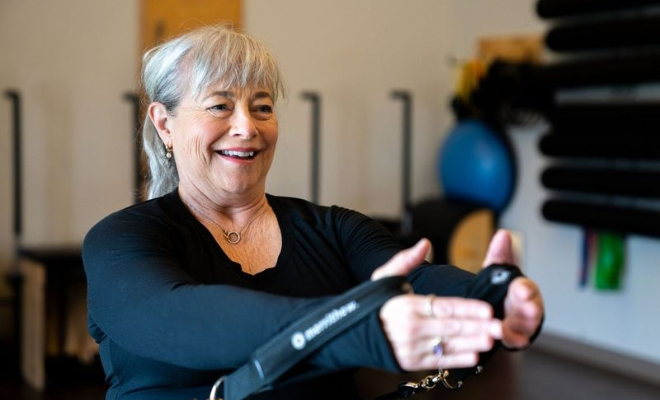
On a sunny New Year’s Day, the snow crunched under my skis as I carved down the slope. Suddenly, I lost control and my vision flashed white with pain as I clutched my left knee. I had torn my ACL and needed major surgery to reconstruct my knee. I was confined to a full-leg cast for months and even once the cast was cut off, my leg was still bent. That’s when the trouble with my gait, balance and strength began.
After many physiotherapy sessions, I returned to being active: running, biking, dance classes, aerobics—just to name a few. Over the years, that knee, along with my neck and back, started to ache and swell. Having taught secondary school for 33 years, including 22 years as a physical education teacher, I was used to always being on the move. Yet, I found myself longing for the days when physical activity was synonymous with joy, not pain. From massages to physiotherapy to facet joint injections, I tried anything to reclaim my life and keep me on my feet.
During the early stages of the COVID-19 pandemic, the pain escalated into numbness and weakness. Fortunately for me, I was already under the care of a pain management specialist who promptly ordered an MRI of my back. One of the main issues the doctor pointed out was chronic cauda equina syndrome, a nerve compression at the base of my spine. I was warned to go to the hospital if anything got significantly worse.
With the pandemic restrictions lifting, I pushed through a busy summer of social commitments, despite the intensifying pain. My back was so crooked, I looked like I’d been cut in half and put back together all wrong. I had lost inches off my height and my right hip was also throbbing. I became a shadow of my former self, making my friends and family very concerned.
After waiting over 10 months to see a spine specialist, I couldn’t wait any longer. The constant pain made me feel like I was slowly deteriorating. I went to the Emergency Department at University Hospital (UH), using a cane to travel around the facility. X-rays and CT scans brought concerning news: not only was my hip arthritic, but my back needed immediate attention.
I was referred to Neurosurgeon Dr. Victor Yang at London Health Sciences Centre (LHSC) and his Fellow, Dr. Marcelo Oppermann. They were open and honest about the gravity of my condition—I needed surgery.
They discussed their surgical solution in detail and genuinely listened to my questions. This would be the first time this procedure would take place in Ontario, and I was the lucky one having it done!
The morning of my surgery, I was anxious, but the nerves slowly dissipated when both doctors greeted me with warm smiles. After nine hours in the operating room, Dr. Yang and Dr. Oppermann were by my bedside telling me it was a success. I couldn't believe it. I’m so appreciative of the entire surgical team, particularly the anaesthetists who kept me alive during the procedure.
While recovering, I had the utmost care by a wonderful team of doctors, nurses, personal support workers, physical therapists, occupational therapists and more. Dr. Oppermann's frequent visits—and his genuine pleasure in my progress—meant the world to me.
A year and a hip replacement later, I’m nearly pain-free with almost perfect posture. I’m walking without a cane and have started to work out again. Renée, my Pilates instructor and co-owner of Create Balance Pilates, has been a key part of my recovery, guiding me through exercises to enhance my mobility and strength. My friends and family keep telling me how great I look. I’m always excited for my next follow-up appointment since I want to show the team the strides I’ve made. I’m truly grateful to both Dr. Yang and Dr. Oppermann, their teamwork and collaboration have completely changed my life.